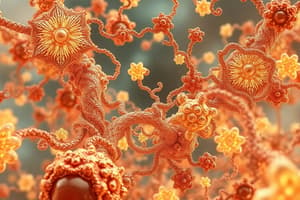Podcast
Questions and Answers
What is diffusion, and how does it work?
What is diffusion, and how does it work?
Diffusion is the random movement of particles from a region of high concentration to a region of low concentration. It works due to the constant motion and collisions of particles.
List two factors that could increase the rate of diffusion.
List two factors that could increase the rate of diffusion.
Warmer temperatures and increased air movement can both increase the rate of diffusion. These factors help particles move faster and spread more easily.
What happens to the movement of particles at equilibrium?
What happens to the movement of particles at equilibrium?
At equilibrium, the net movement of particles stops, meaning that there is no concentration gradient. However, individual particles continue to move randomly.
How does the distance that particles travel affect the diffusion rate?
How does the distance that particles travel affect the diffusion rate?
Explain why molecules in solids do not diffuse like they do in liquids and gases.
Explain why molecules in solids do not diffuse like they do in liquids and gases.
What role does spraying perfume with force play in diffusion?
What role does spraying perfume with force play in diffusion?
Summarize the relationship between temperature and the rate of diffusion.
Summarize the relationship between temperature and the rate of diffusion.
What would happen to the diffusion rate at high altitudes, and why?
What would happen to the diffusion rate at high altitudes, and why?
Flashcards
Diffusion
Diffusion
The random movement of a substance from an area of high concentration to an area of low concentration. It's like a crowd of people moving from a crowded area to a less crowded one.
Diffusion Rate
Diffusion Rate
The rate at which a substance moves during diffusion.
Equilibrium
Equilibrium
A state where the concentration of a substance is equal throughout a space. It's like having an even distribution of cookies in a cookie jar.
Passive Process
Passive Process
Signup and view all the flashcards
Concentration Gradient
Concentration Gradient
Signup and view all the flashcards
Molecular Motion
Molecular Motion
Signup and view all the flashcards
Diffusion of Particles
Diffusion of Particles
Signup and view all the flashcards
Diffusion at Equilibrium
Diffusion at Equilibrium
Signup and view all the flashcards
Study Notes
Diffusion Definition and Mechanisms
- Diffusion is the random movement of a substance from a high concentration area to a low concentration area. This movement is down the concentration gradient.
- Diffusion is a passive process; no energy is required.
- Diffusion is driven by the random motion of particles.
- Molecules in liquids and gases are constantly moving and colliding with each other, which leads to their spreading out.
- Diffusion in solids does not occur.
Factors Affecting Diffusion Rate
- Decreasing the diffusion rate: Increasing the distance, decreasing temperature, and reducing the concentration gradient.
- Increasing the diffusion rate: Increasing temperature, increasing air flow, increasing the concentration difference or decreasing the distance travelled.
Diffusion and Equilibrium
- Diffusion continues until equilibrium is reached. Equilibrium is when the concentration of the substance is uniform throughout the space.
- Even at equilibrium, particles still move randomly. Individual particles move, but the net movement stops because there's no longer a concentration gradient.
Diffusion and States of Matter
- Diffusion occurs in liquids and gases, but not in solids. The molecules in liquids and gases move constantly which enables them to spread from high to low concentration regions.
Perfume Diffusion Example
- Several factors can increase the rate at which perfume spreads:
- Warmer temperatures: Particles move faster.
- Air movement (e.g., fans, open windows): Carries the scent particles.
- Spraying with more force: Initial dispersal is increased.
- Less crowded air (e.g., higher altitudes): Fewer particles to collide with.
Diagram of Diffusion (Conceptual)
- (No diagram can be created here, but imagine a diagram showing a container with a high concentration of particles on one side and a low concentration on the other. Arrows would start thick on the high concentration side, then thin out, as the particles diffuse across going towards the low concentration)
Diffusion Equilibrium
- At equilibrium, molecules are evenly distributed, but particles still move randomly.
- The net movement of particles stops at equilibrium.
Studying That Suits You
Use AI to generate personalized quizzes and flashcards to suit your learning preferences.




